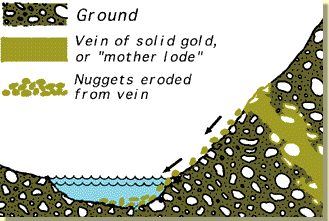![]()
![]()
![]()
![]()

Have you ever dreamed of finding gold? Well, you're not alone! Many people, professional and amateur, still search the Cariboo looking for gold. While all dream of finding a lost mine or missed mother lode, most follow tried and true methods of prospecting which are easy to learn. Below you'll find some tips to increase your chances of striking it rich.
For a moment, let us drift back to the dawn of time when gold was first being forced into cracks and crevices. These veins or lodes were the first sources of gold-solid streaks in the earth's crust. Over the centuries these lodes were exposed to the grinding effect of glaciers, and the relentless effects of the elements-wind, rain and snow. In cold climates, water seeped into minute cracks in the rocks. It then expanded on freezing, gradually enlarging and deepening the cracks until, eventually, chunks were broken off.

This diagram illustrates how gold gets into the streams and rivers. The 'Mother Lode' [solid gold] becomes exposed at the surface of the earth. Here, exposed to the elements-wind, rain, snow, earth tremors, etc., the lode gold is broken off and eventually works its way down the mountainside, and into the streams and rivers.
These flakes and nuggets were then carried downhill by the spring run-off until they reached a stream or river. Each spring nature replenishes her streams in this fashion. Placer deposits, then, are the results of decomposition and the wearing away of veins and lodes.
You now know how placer gold gets into a stream, but now we must learn what happens to the gold after it enters the stream. One essential fact should always be uppermost in your mind when searching for gold-GOLD IS HEAVY. Because of this one singular fact, gold will accumulate at certain spots in a creek or stream after it has been carried there. Your ability to recognize these locations could be the difference between a long, tedious, unrewarded effort, and success. Regardless how impatient you may be to get started, you cannot merely approach a stream and begin panning indiscriminately-not if you want to recover gold. Panning gold requires hard work, both mental and physical.
Knowing how gold behaves can help you find it.

Visualize, for a moment, a cork floating downstream. Watch it as it is carried over the waterfall and plunges, temporarily, beneath the surface. Then it bobs to the surface and continues downstream until grabbed by the whirling motion of a suction eddy. Eventually freeing itself, it continues its journey until its path is blocked by a huge boulder. Here, its progress is impeded until the current forces it around the edge. Finally, the cork is trapped where a fallen tree trunk spans the surface of the stream.
A piece of gold will react in much the same way. However, as it plunges over the waterfall, the heavier pieces will continue to the bottom, and will not resurface. Lighter pieces may be carried by the water's velocity to the eddy, where the current slows sufficiently to allow them to sink. Similarly, gold that is hindered by an obstruction will not merely float as did the cork, but will take advantage of the reduced waterflow and obstruction, and sink. And whereas the cork would bob indefinitely where trapped by the fallen tree, the heavier gold would settle to the bottom.
Three More Hints:
If you are prospecting a stream about which you know absolutely nothing, here are 3 more indicators that you should become acquainted with:
|
Last updated November 30, 1998. |


